More about Thimbles





Magdalena and William Isbister.
The humble blackberry is not a true berry since it did not arise from a single ovum. In fact, it is a false berry and the aggregated fruit of the bramble bush. There are several hundreds of species of blackberry and it is a native of the Northern Hemisphere. It is said that it should not be picked after the 29th of September because at this time it has been claimed by the devil.
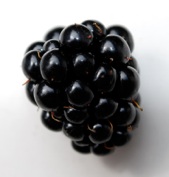
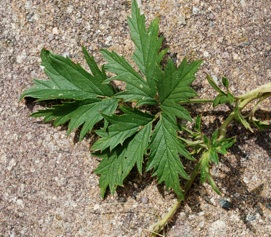
Fig 1 Fig 2
English ‘’blackberry’ thimbles are based on the design of the bush itself (Fig 2, 4) and or the aggregated fruit (Fig 1, 3). Designs were hand engraved, chased, or bright cut and it is unlikely that any two thimbles were identical for this reason. Some of the blackberry thimbles may have been made by well known ‘thimble makers’ and then stamped by the selling jeweller.
Holmes in 1985 (1) illustrated five thimbles but did not comment specifically upon them. The earliest hallmark of the five was for Henry Griffith, 1895. Pelham Burn wrote about blackberry thimbles in 1994 and then again in 2005 (2) when she claimed that the earliest blackberry thimble to be dated was from 1893, there were 21 different people making the thimbles and that James Fenton alone made 9 varieties.
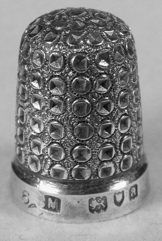
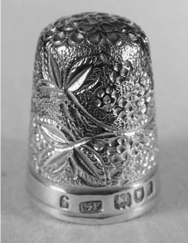
Fig 3 Fig 4
The left thimble (Fig 3) was made by Charles C May and Sons, London in 1896 and the right thimble (Fig 4) was made by Samuel Foskett, London in 1901,
Based on our own observations and examination of the literature we have been able to classify the thimbles into thirteen distinct groups. There may, of course, be other blackberry thimbles that we have never seen that constitute other groups but we feel that this is unlikely.
We have assumed that the thimbles described in this paper were all made within two years of the year that they were hallmarked and cover a span of about 50 years (1878-1927).
-
1.Top only aggregated fruit
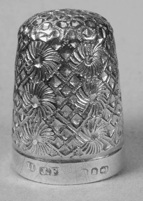
Fig 5
These thimbles may have any design on the side of the thimble but the top clearly has an aggregated fruit dimpling. James Fenton of Birmingham made this thimble in 1895. James Fenton also made this design (Fig 6) with both sunflowers (3) and thistles on the border (4).
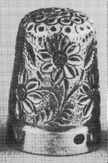
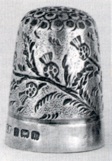
Fig 6
2. All over aggregated fruit
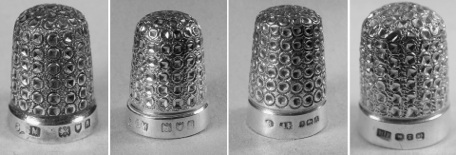
Fig 7
All of these thimbles have an aggregated fruit top and vertical rows of fruits above a flat rim. From left to right the makers are: Charles C May and Sons, London, 1896 and 1897; James Fenton, Birmingham, 1925; and Henry Fowler, Birmingham, 1899.
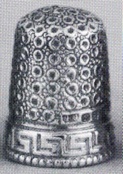
Fig 8
A rare group two thimble (Fig 8) with aggregated fruit over a Greek key band and a beaded rim. Unknown maker. Could it be a hybrid (5)?
3. Aggregated fruit above leafy band

Fig 9
Thimbles in this group are similar to group 2 thimbles but in group 3 there is a leafy band between the rows of fruit and the rim. From left to right the makers are: unknown, Birmingham, 1878; James Fenton, Birmingham, 1895; Olney Amsden and Son, London, 1900; William James Holmes, Birmingham, 1913; and unknown, London 1902.
We have chosen to include the above three categories in our classification of blackberry thimbles because, although there is some discussion regarding whether the designs relate to the aggregated fruits or simply a pattern of multiple ‘roundels’, the same patterns are seen on all other blackberry designs and so we feel that the ‘roundels’ represent the fruit of the blackberry and not simply an abstract design.
4. Single aggregated fruit band

In this group the tops may have various patterns from simple dimpling to a daisy pattern. The band may consist of a combination of aggregated fruits and leaves (Fig 10, 11, 12), two rows of fruits and another pattern (daisy) (Fig 13), or a single band of aggregated fruits (Fig 14). From left to right the makers are: James Fenton, Birmingham, 1893; Samuel Foskett, London 1902; James Fenton, Birmingham, 1911; Mitchell Brothers, Birmingham, 1895; and Henry Fidkin, Birmingham, 1920.
In 1888, James Fenton registered a ‘Gripper’ thimble with triangular dimpling (Rd 103216 - Gripper thimble - James Fenton, 7.7 1888). One variety of this thimble is known to have a single aggregated fruit band.
5. Multiple aggregated fruit bands
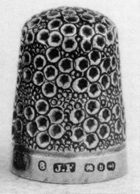
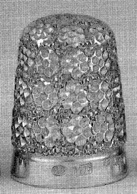
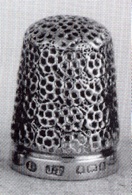
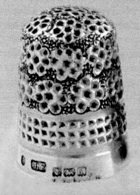
Fig 15 Fig 16 Fig 17 Fig 18
Thimbles with double (Fig 15), triple (Fig 16) and quadruple (Fig 17) aggregated fruit bands above a plain flat rim and without intervening leaves were made by James Fenton, Birmingham in 1895, 1901, and 1902 respectively.
A variant of the double aggregated fruit band was also made by James Fenton in 1905. In this design the double aggregated bands were arranged above a waffle band, and the top of the thimble was of aggregated fruit (Fig 18).
6. Multiple aggregated fruit bands (single fruits)
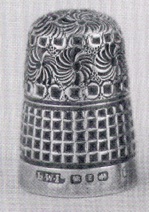
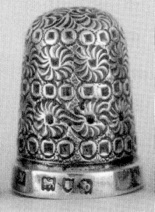
Fig 19 Fig 20
These thimbles seem to be uncommon but we include them because of the shape of the fruits. The thimble shown in figure 19 had two bands of fruit whereas the thimble shown in figure 20 has three such bands. From left to right; unknown maker, Birmingham, 1899; Charles May, London, 1897.
7. Double aggregated fruit and leafy bands
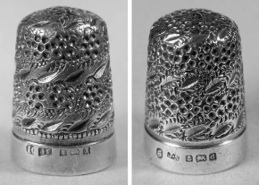
Fig 21
In this group, aggregated fruit bands alternate with leafy bands. From left to right the makers are: James Fenton, Birmingham, 1922; and James Swann, Birmingham, 1903.
8. Vertical rows of aggregated fruit without or with leaves
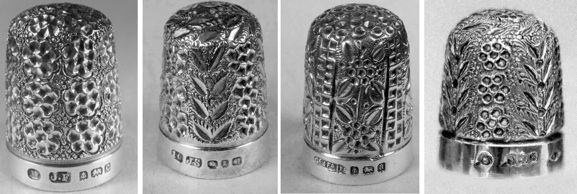
Fig 22
Thimbles in this group have vertical rows of aggregated fruits separated by a patterned background or by vertical rows of leaves. From left to right the makers are: James Fenton, Birmingham, 1927; and James Swann, Birmingham, 1900; Constantine and Floyd, Birmingham, 1900; Henry Foskett, Birmingham, 1918.
9. Blackberry bush leaves with aggregated fruit
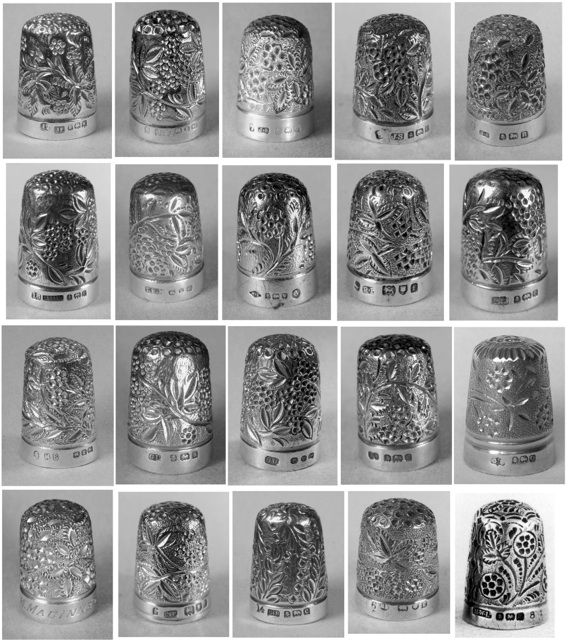
Fig 23
This is the commonest type of blackberry thimble and the design consists of both the bush and aggregated fruits. Some of the tops are aggregated fruit only where as others are all over bush leaves and aggregated leaves. It is these thimbles that are understood to be a ‘blackberry’ thimble by most collectors. From left to right and top to bottom, the makers are: James Fenton, Birmingham, 1921; James Fenton, Birmingham, 1901; James Swann, Birmingham, 1915; James Swann and Sons, Birmingham, 1927; James Swann, Birmingham, 1912; Henry Griffith and Sons Limited, Birmingham, 1904; Thomas Edward Mannox, Birmingham, 1897; Henry Fidkin, Birmingham, 1920; Robert Pringle and Sons, London, 1901; Henry Fowler, Birmingham, 1904; Henry Swann, Birmingham, 1894; George Unite, Birmingham, 1900; George Unite, Birmingham, 1886; Henry Fowler, Birmingham, 1902; Gomm's, Birmingham. James, 1913; Swann, Birmingham, 1912; Samuel Foskett, London, 1901; Christopher Buckton, Lightcliffe, Yorkshire, 1902; and Samuel Foskett, London, 1902; Henry Williamson Ltd., Birmingham, 1900.
A ‘Non-slip’ thimble, marked ‘N.B.& Co.’ (6), and probably made by Henry Griffith and Sons Limited, Birmingham also has an all over bush and aggregated fruit design (Fig 24).
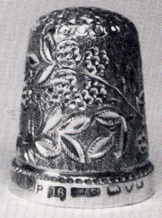
Fig 24
This bush leaf and aggregated fruit design is very unusual in that the leaves are all above the aggregated fruits and below a single circle of fruit on the top of the thimble (Fig 25). Henry Griffith and Sons Limited, Birmingham, 1900.
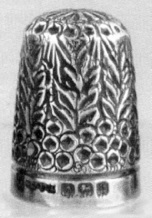
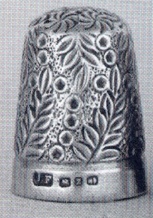
Fig 25 Fig 26
Another variation of this type comprises leaves with single interspersed fruits (Fig 26). James Fenton, Birmingham, 1889.
10. Aggregated fruit background with bicycle
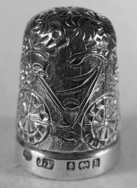
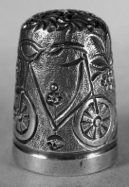
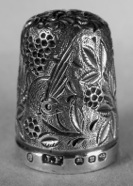
Fig 27
There are several bicycle designs (7) - with and without a cross bar, with and without a chain mechanism and with or without solid tyres (Fig 27). These differences probably reflect the desire of the engraver. All thimbles have fruits on the top and a bird on the side opposite to the bicycle. James Fenton, Birmingham, 1901 and 1897.
11. Aggregated fruit with place name
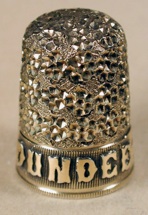
Fig 28
This gilded thimble is the only one of this design that we have seen. It is clearly a blackberry thimble with an over all aggregated fruit design above a place name. It must have been a souvenir of Dundee. It was made by James Swann, Birmingham in 1898. Similar place souvenir thimbles were made with some of the other blackberry designs described above.
12. Aggregated fruit with leaves in panels in border
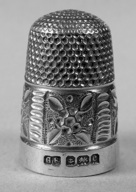
Fig 29
This thimble which has a border divided into four panels, each containing an aggregated fruit and some leafy representations, was made by George Smallwood, Birmingham in 1902. A similar thimble is listed as a ‘blackberry thimble’ in a TSL Magazine (8) devoted to thimbles made by Charles Horner of Halifax.
13 Nickel Silver bush and aggregated fruit.
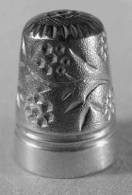
Fig 30
Almost certainly this less expensive example of a blackberry thimble was made by Charles Iles and Company, Birmingham at the beginning of the 20th century. This design has been identified with an Iles mark (personal communication, Wolf-Dieter Scholz).
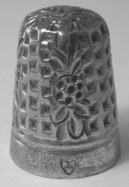
Fig 31
This second Nickel blackberry thimble does bear the mark of Charles Iles and Company.
Many makers made blackberry thimbles at the end of the 19th century and the beginning of the 20th century. Most of the thimbles had flat rims but some were round and turned over (Fig 10, 11, 12, 28) and some were engine turned (Fig 13). We identified at least 30 different maker’s marks. We cannot be sure whether all of the thimbles were made by the jewellers who hallmarked the thimbles and since all were individually made it is not possible to identify a maker from the design on a particular thimble. There can be little doubt that known thimble makers such as James Fenton, James Swann, Henry Fidkin, Samuel Foskett, Henry Griffith, George Unite, Henry Fowler and Charles May made their own thimbles but it is more difficult to be sure that the other jewellers whose names appear on blackberry thimbles actually made the thimbles that they marked.
We have not found a single Charles Horner blackberry thimble and neither did Pelham Burn (2). Charles Horner was one of the more prolific thimble makers of the time and it seems very strange that there are so few of his blackberry thimbles to be found. It may be that they are ‘just all in the sewing boxes of Halifax ladies’ (personal communication, Norma Spicer). There are no blackberry thimbles, however, to be seen in a catalogue page from the beginning of the 20th century for Charles Horner but a James Fenton catalogue from the same time shows at least six blackberry thimbles (1). Three Charles Horner blackberry thimbles, however, may be seen in a TSL Magazine (8).
James Fenton was responsible for the greatest variety of blackberry thimble designs. It is not known who first made a blackberry thimble but what is certain is that around the same time many other thimble makers copied the design. An unknown maker made the earliest blackberry thimble that we have seen in 1878. Our first known maker was George Unite of Birmingham in 1886.
As time passes, more and more blackberry thimbles and more designs seem to turn up so in a few years time some other collectors will be writing another paper about Blackberry thimbles as our knowledge increases further.
We are grateful to Ray Nimmo for supplying the picture of the thimble in Fig 31, and Norma Spicer for allowing us to use her pictures of the 1913 all over bush leaves and aggregated fruit thimble by Gomm's, and the pictures in Figures 11 and 12. Bridgett McConnel, TSL, kindly gave permission for the use of the images in Figures 6, 8, 15-20, the last images in Figures 22 and 23 and Figures 24, 25, 26.
References
-
1. Holmes EF. A history of thimbles. London: Cornwall Books, 1985. pp. 49.
-
2. Pelham Burn D. Blackberries: The Pick of the Crop. 1994, Spring and 2005, Summer; TCI Bulletin.
-
3. TSL Magazine. 1988; 3(4): 9
-
4. TSL Magazine. 1995; 5(7): 18
-
5. Isbister M, Isbister W. Hybrid Thimbles. 2009, Winter, TCI Bulletin.
-
6. TSL Magazine. 1985; 2(3): 14
-
7. Spicer N. James Fenton Silversmith and Thimble Maker etc. 1994. pp. 27
-
8. TSL Magazine. 1990; 3(10): 6
TCI Bulletin Spring 2011
Holmes: ‘Thimbles in England’ pp. 49.
Researched and published in 2002/11
Copyright@2011. All Rights Reserved
Magdalena and William Isbister, Moosbach, Germany
Addendum (6/2013)
Another variety of the type 4 (Single aggregated fruit band) thimble has recently been found. The thimble was made by Francis Webb of Birmingham and was assayed in 1895.
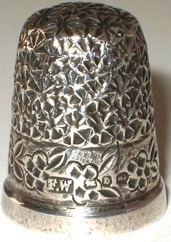
Blackberry thimbles
Navigation
